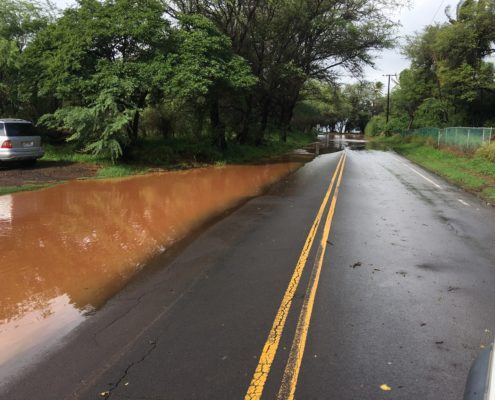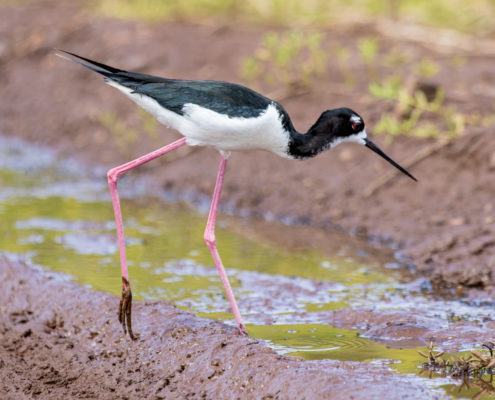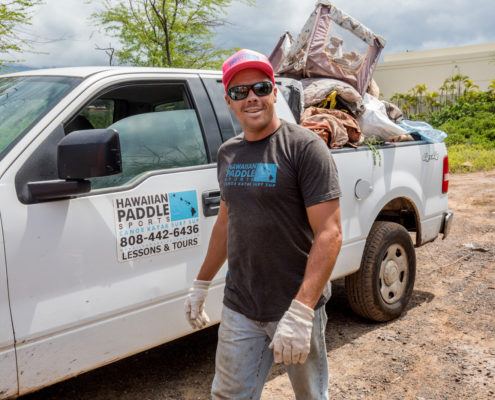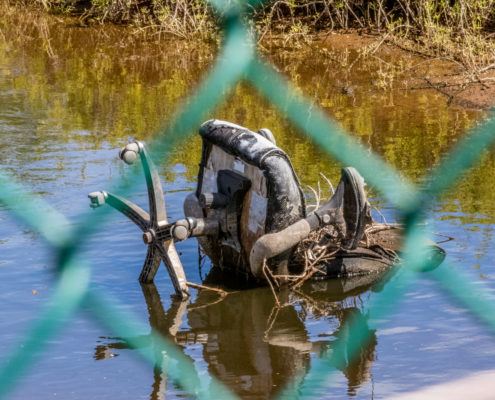When we moved into our new baseyard in Kihei and saw the piles of trash that had accumulated in the wetlands behind us and our neighbor the Salvation Army, we knew something had to be done. During the cleanup we pulled out enough clothing, bedding, furniture, toys, books, and other things to fill two roll-out dumpsters to the top.
The Cleanup
Why It’s Important
Coastal Wetlands like the La`ie wetlands in Kihei play a vital role in the health of our oceans and coral reefs. By allowing rainwater to spread out and slowly seep into the ground, sediment is able to settle down rather than flow out into the ocean and choke off our reefs. In addition, the wetlands are habitat for endangered, native ae’o (Hawaiian Stilts) and native plants.
The Salvation Army joined us at the cleanup and is taking steps to secure their property with a security fence and lockable dumpster.
Hawaiian Paddle Sports employees participated in the cleanup as part of our monthly Malama Maui campaign.
Photos of trash in wetlands
What Are Wetlands?
It’s landscape with water.
Think of it as a transitional area between land and water mass, characterized by three factors:
- Presence of plants that only grow on water
- The ground is saturated with water, leaving the soil very low in oxygen
- This saturation or standing water is present during growing season
Living on an island like Maui, we have a lot of transitional areas between the land and our ocean.
Photos of Kiehi wetlands
Why Are They Important?
It may just look like water flooding an area, but there are several very important things happening.
Do you like surfing or swimming in brown water? Neither do we. More importantly, neither do our coral reef ecosystems in the ocean. When we get a lot of rain on Maui, it has to go somewhere and in the end that somewhere is directly into the ocean. Imagine a flood. Rain is indiscriminate and falls on everything including mountains, volcanoes, roads, yards, parking lots, farms etc. Think of everything that comes into contact with each of those areas and how much of that could be picked up in a flood. Fertilizer, weedkillers, gasoline, oil, and even plain old dirt are all eligible to ride this water slide.
This is where wetlands come into play. Rainwater flows through watershed areas and meets wetlands either directly or through groundwater. The wetlands operate like a giant sponge and soak up the floodwater. When wetlands are properly preserved and allowed to operate, they filter out a lot of the hitchhikers we mentioned before they head into the ocean. The sponge effect reduces the floodwaters’ impact on our developed areas. Back in the day, wetlands were viewed as unkempt areas that needed to be controlled by development. Sadly, this sentiment caused us to lose many of these important areas. With the knowledge we have today, we need to work to preserve the remaining wetlands in our environment.
Photos showing brown run-off water flowing into the ocean
What Happens If We Lose Our Wetlands?
Erosion
Without the giant sponge to stop floodwater, runoff erodes our coastal areas.
Flooding
The same sponge action gives floodwater a place to go as opposed to our homes, yards, and agricultural areas.
Pollution
Toxins in our land environment are not healthy for our ocean ecosystems. Without the wetland interface, fertilizers, weedkillers, and other chemicals picked up along the way flow directly into the ocean.
Sediment buildup on coral reefs
Dirt picked up in floods turns into life suffocating sediment that covers our coral.
Loss of habitat for native plants and birds
Hawaii has several species that are endemic to the islands meaning they are not present anywhere else in the world. Some of these species call the wetlands their home.
Photos of flooding in Kihei
What’s Significant About The La`ie Wetlands?
Photos of ae`o or Hawaiian stilts in wetlands
The La’ie Wetlands are part of the small remaining network of wetlands in Kihei. In addition to the factors mentioned above, there are native species who have taken up residence in the area. If we want to keep them around and protect them from extinction, we need to preserve the wetlands.
Native Birds:
- Ae‘o or Hawaiian Stilt (Himantopus mexicanus knudseni meaning one standing tall) – This bird is endangered and endemic to Hawaii. It has been frequently observed by Hawaiian Paddle Sports employees in the surrounding area. The Ae‘o is extremely vulnerable to predators such as mongoose, cats, and dogs as well as human disturbance.
- Auku’u or Black-crowned night heron – Native, not endemic to Hawaii
- Kolea or Pacific Golden Plover – Migratory and not native to Hawaii
Native Insect:
- Koa Butterfly or Udara Blackburni – There are only two species of butterflies endemic to Hawaii and the Koa Butterfly is one of them.
Native plants
- Bacopa monnieri Bacopa
- Bolboschoenus maritimus Kaluha, makai sedge
- Cyperus laevigatus Makaloa
- Heliotropium curassavicum Ena ena
- Ipomoea pes-caprae subsp. brasiliensis Pohuehue
- Pycreus polystachyos Pycreus
- Sesuvium portulacastrum Akulikuli
- Sporobolus virginicus Akiaki
- Waltheria indica Uhaloa
10,000 POUNDS
5 tons or 10K lbs were removed from the La`ie Wetlands
Sounds Great, What Was The Problem?
We had a very large trash problem. Aerial footage of the wetlands next to and behind the Hawaiian Paddle Sports baseyard showed large amounts of trash scattered throughout the area. The problem was the result of various factors including dumping of cars, homeless camps, and accessibility to the Salvation Army dumpster directly bordering the wetlands. The wetlands are already stressed by many factors previously addressed. Piles upon piles of trash, abandoned vehicles and furniture were not contributing to the overall health of the area.
Photos courtesy of Bryan Berkowitz
What Can You Do To Help?
Spread the word about the importance of wetlands
In addition to educating others, here are some steps you can take in your daily life to preserve wetland areas.
Be responsible with your Trash
- It’s really easy to kick things to the curb, especially when it is already piling up in a spot. Being responsible with your trash and disposing of it properly goes a long way to preserving our wetlands.
Rain Barrels
- Rain is free and readily available! Why not capture it and use it on your lawn or household plants instead of tap? You are capturing it before it goes through chemically intense cleaning processes and preventing it from gathering steam with flood waters.
Plant Native Species
- Our native plants are up against a lot. Why not give them a shot? You might enjoy the benefits of reducing erosion and attracting native birds.
Use Non-Toxic Products
- What you use to clean your house, clothes, car etc. goes somewhere and many times it is straight into the ground. What happens when rain washes it away? Consider using natural or non-toxic products that are less harmful to our ecosystems.
Reduce Use of Fertilizers and Pesticides
- Fertilizers and pesticides are easily washed away by copious amounts of flood water and they don’t help keep our wetlands green and “pest” free. Consider reducing their use to the minimal amount or try natural alternatives.
Don’t Fill Wetlands When Developing Property
- We know a lot more now than we did in the past. Don’t fall into old mentalities of filling in wetlands when developing. It might go a long way to preserving the future of your property.












































